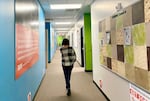Rayshawn didn’t finish his freshman year at the high school he started at last fall.
He’s at Rosemary Anderson High School, an alternative school with campuses all over Portland. Rayshawn is at the east campus — a small building in an old strip mall. It feels a little like it used to be an office space, with bright accent walls, fluorescent lights overhead, and a main hallway that runs the length of the school.
It’s quite a difference from where he started, surrounded by friends at David Douglas High School, the largest high school in the state, in a district Rayshawn has attended since his first day of kindergarten.
“Going from one school to another felt kind of weird, and then, just normal after that,” Rayshawn said of his first year of high school.
Rayshawn is part of OPB’s Class of 2025, a group of 27 students OPB is following from first grade to high school graduation. All of the students started school together at Earl Boyles Elementary in Southeast Portland. Now, they’re scattered across Oregon and Southwest Washington.
Rayshawn’s family hasn’t moved, and it wasn’t anyone’s plan for him to leave David Douglas.
Rayshawn enrolled at Rosemary Anderson after getting in trouble at David Douglas High back in the fall. The family said another student brought a toy replica gun to school, and Rayshawn pointed it at a friend. Several students were disciplined, including Rayshawn, who isn’t allowed back at David Douglas until his sophomore year.
Rayshawn and his parents, including dad Rayshawn Sr., were nervous initially about changing to an alternative school.
“At first, I was skeptical of the place too,” Rayshawn Sr. said. “...As he started going, I just started actually liking it. The people are really nice there, and I didn’t see all the trouble that I was told was going to be there, because I was really worried about him going there, getting into trouble.”
To go to Rosemary Anderson, a student has to be referred by their home school as needing something different, often for academic or behavioral reasons. Students there might have jobs, have children, or be experiencing homelessness or other problems at home.
Rosemary Anderson students are usually older, first or second-year seniors working to get a diploma, earn a GED, or take advantage of job-training opportunities. Rayshawn is there in ninth grade, years before other kids typically land at the alternative high school.

A student walks down the hallway at Rosemary Anderson High School’s east campus. The alternative high school program is small and serves students who are referred by their home school.
Elizabeth Miller / OPB
“Generally, we don’t take very many freshmen, that’s because the school districts, rightfully I think, really want their incoming freshmen to try the comprehensive high school before they refer them out to another placement,” said Rosemary Anderson East campus principal Erin Kent.
After a bumpy start to freshman year, Rayshawn settled in at his new school, where he said he feels supported and his teachers said he’s succeeding academically.
Rosemary Anderson and David Douglas high schools present Rayshawn’s family with a choice to make as they contemplate the teenager’s academic journey ahead: a new, smaller environment where Rayshawn is succeeding in spite of his unplanned arrival, or a return to Oregon’s largest high school, where he has friends and far more extracurricular opportunities.
At Rosemary Anderson, smaller classes, one-on-one attention
At home this past spring, Rayshawn and his Dad sit on the living room couch, surrounded by family photos and framed art on the walls. As the family dogs mill around, Rayshawn says his grades have improved since transferring to Rosemary Anderson. His latest report card is up on the fridge.
“He has all “A’s’ and one ‘B’,” Rayshawn Sr. said.
Rayshawn Jr. said he likes his hands-on art class, and learning about inventions in science.
Rosemary Anderson’s east campus enrolls about 100 students. But on a recent day this spring, there were only about 35 on campus.
Both Rayshawn and his dad see advantages to the school’s small size. Rayshawn Sr. said there are fewer distractions at the school. His son said he likes the one-on-one attention.
“There’s only like five to 10 kids in a class max,” Rayshawn Jr. said.
One afternoon near the end of the school year, Rayshawn walks the short hallway at Rosemary Anderson in a green Nike hoodie, joking with classmates as he goes from one class to the next. In his homeroom, he sits at a table right in front of teacher Brooke Birch, where he chats and laughs with Birch and his classmates. Nine students are in the class, filling out career interest surveys before talking about their answers. Rayshawn scored highest for skills related to the manufacturing industry. Rayshawn says the results feel “kind of” accurate.
This is Birch’s first year at the school. They teach social studies.
“Here, we’ve recognized that smaller class sizes directly correlate to better participation, higher engagement, higher grades,” Birch said.
Colorful posters cover the walls of Birch’s classroom. There’s flexible seating everywhere, including chairs and bean bags. The lights are soft and a diffuser fills the room with the scent of oranges and roses. Those additions are part of Birch’s efforts to create a comfortable school environment.

Teacher Brooke Birch sits at their desk at Rosemary Anderson High School’s east campus.
Elizabeth Miller / OPB
“More than anything, especially with our demographic of students, I want it to be safe,” Birch said. “I think that takes precedence over any learning outcome in the classroom, is that they have to be comfortable and safe.”
The class came up with a set of classroom rules at the beginning of the year, which Birch said created a sense of respect and responsibility the students want to maintain.
“Our main goal really, especially with the younger students, is to take them out of places where they weren’t succeeding and put them into an environment that they have the most amount of time to grow and succeed, and participate in a system that cares about them and cares about their trauma and cares about the things that they’re going through on the daily,” Birch said.
Rayshawn said another aspect he likes about his new, smaller school is that he knows everyone — some of them from an old church his family used to go to. He likes that the school isn’t “packed” with students.
“It just feels more safe…there aren’t random people,” he said.
He compares his teachers to his parents, pushing him to meet his potential.
“They’re just on your back about getting your grades up and stuff — it’s just like a school full of parents,” Rayshawn said.
Science and health teacher Aubrey Williams has taught in public schools before, but she’s been at Rosemary Anderson for six years. She said the school is different from a comprehensive public high school, because it can change its program to meet the needs of its students.
“Our flexibility, and adaptability, and I think, the open-mindedness, the fact that you’ve got a group of teachers, who, no matter what your lived experience has been, we want to know about it,” Williams said. “We’re here to receive it, and we just want to support you and just welcome you with open arms.”
Williams said it was easy to connect with Rayshawn when he first arrived at the school.
“You can kind of nudge him a little bit, and he’s easy to rein in and kind of get back on track just through a lot of love and joking around,” Williams said. “He’s just got a great sense of humor… he’s helpful if I need help moving a table, or anything like that, he just jumps right in.”
“Even the security guard is pretty cool, he keeps my son in line,” Rayshawn Sr. said. “...They got their little rapport.”
Rayshawn describes Ronnie Wallace as a “chill, relaxed” security guard.
Around lunch, students stand around Wallace’s desk near the school’s entrance. The security guard — and PE teacher — said students flock to him for his snack drawer.
Like Rayshawn’s social studies teacher Brooke Birch, Wallace emphasizes providing a safe space for students and helping them reach their goals. For Wallace, that includes hosting a men’s group where students talk about life, and their plans after high school.
“I just want them to graduate and get an education, basically, that’s what we talk about, and try to keep their minds off the streets,” Wallace said. “A lot of them, they come to school because they want to learn, but it is what it is.”
Over the years, the school’s leaders have joined countywide efforts to reduce gun violence. Some students attending the school have entered the criminal justice system. Others have been shot, even killed.
Wallace checks every student who comes into the school daily, waving a security wand over them and checking backpacks for weapons. He’s happy to be there for the students.
”I love them like they’re mine,” Wallace said, before going back to joking around with the students sitting around him.
Alternative schools serve students at risk of not graduating
Alternative schools, as their name suggests, are meant for students who need an “alternative” to a comprehensive high school. Beyond placement for academic or behavioral reasons, students in alternative programs may be in long-term care and treatment settings, or having surgery that requires in-home instruction.
Alternative schools serve students at high risk of not graduating, and it’s possible for students to move between alternative and traditional programs. However there is little information or oversight on how those students are doing academically, and achievement data specific to alternative schools is hard to come by.
There aren’t many alternative schools in Oregon, and a 2017 Secretary of State audit found very little accountability for these schools from the state. Five years later, the state has yet to fully implement the audit recommendations, including one to develop and publicly share measures to evaluate alternative schools and programs, though the Oregon Department of Education now has an Alternative Education Advisory Group.
Rosemary Anderson boasts a 92% graduation rate for the Class of 2020, which includes students who graduated in four years, five years, and students who received a GED. Oregon’s official graduation rate doesn’t include GEDs — only diplomas.
The different Rosemary Anderson campuses serve students from school districts all over Portland, some of whom are dealing with life situations that can take precedence over academics, such as gun violence.
Aubrey Williams’ classroom is a few doors down from Brooke Birch. Hanging from the ceiling in Williams’ room are three-dimensional snowflakes that her students created. Surrounding those are dove-shaped balloons; each one with the photo and name of a student whose life was suddenly cut short. Some were shot or stabbed. Others died in car crashes. There are nine altogether — one for each student who died during the last two school years.
“I wanted to memorialize my kids in a way that felt like we weren’t just sweeping the issues under the rug,” Williams said.

Rosemary Anderson teacher Aubrey Williams sits in her classroom. On the ceiling are balloons in memory of students who have passed over the years.
Elizabeth Miller / OPB
Williams said sometimes a sibling of a student who died wants to go to Rosemary Anderson because of that connection to the person they lost.
“To see their faces when they come in and they see that their brother …has been remembered has been pretty impactful, it let me know that I was doing the right thing.”
Traditional school model “doesn’t work for everybody” in high school
In the David Douglas School District, a relatively small number of students are enrolled across more than 20 different alternative programs, including Rosemary Anderson.
The district also operates its own alternative school, Fir Ridge, which has about 140 students.
Joe Talley is an assistant principal at David Douglas High School who helps students get placed in alternative programs. He sits down with families and asks them where they think students will be the most successful. It may not be at the district’s large comprehensive high school.
“We try to put everybody through the same thing, and that doesn’t work for everybody,” Talley said.
Talley said it’s rare for students to go from an alternative school back to the David Douglas High, but it does happen, including a couple of times this year.
David Douglas officials say the state “doesn’t provide” a different graduation rate for students who have spent time during their high school years in an alternative placement. Rather, the district’s graduation rate includes all students the district is responsible for, including students who leave high school without a diploma.
Talley said alternative schools provide an option for students who might otherwise fall through the cracks and give up on their education.
“If we can keep a student engaged in the educational process… and we can move them farther than we got them, that’s success,” Talley said.
Rosemary Anderson’s Birch says the alternative school model is one that “works for students that other models have not worked for, other systems have not worked for.”

Rayshawn takes a career quiz during his homeroom class with teacher Brooke Birch, behind him. Birch said the alternative school model is successful in part due to small class sizes.
Elizabeth Miller / OPB
“When you look at the students that we serve, and you see the success that they have with our school, that should just be a huge green flag, of ‘do this everywhere, do this everywhere!’,” Birch said.
Birch said alternative education models should be more available to students, not just as a last resort.
“Right now, this type of education only exists alternatively. These students have to fail to be able to come here — that’s ridiculous, none of these students should have to fail before they can succeed.”
Next year: a car, good grades… and a new school?
Ask Rayshawn what he wants in the next year, and it’s a list you’d expect from a 14-year-old a few months away from 15… and a driver’s permit.
“I want to get a car, keep the same grades that I have right now, that’s it,” Rayshawn said. He adds one more thing. “Get a job… just something to make money until I’m out of high school.”
He also wants to go back to David Douglas High — and play sports. He tried playing football at David Douglas last year, but he said next year, he wants to play basketball there and reconnect with old classmates.
“I want to go back for my friends, just because I know everybody from elementary that goes there,” he said.
Rosemary Anderson’s Williams says if a student leaves the school, it’s usually because of sports. But she said a lot of students stay.
“I think what happens is that we just grow on them, and then when they come here, they think, ‘oh I want to go back to my neighborhood school,’” Williams said. “But then, by the time they’ve spent a year with us, they’re just hooked.”

Class of 2025 student Rayshawn and his father, Rayshawn Sr., at home with one of their dogs. Rayshawn just finished his freshman year of high school at Rosemary Anderson, an alternative school.
Elizabeth Miller / OPB
Rayshawn’s dad is torn.
“I like him where he’s at, but I know I want him to be able to have the experiences of high school, the dances, and so forth,” Rayshawn Sr. said.
“But I just want him to be able to make good decisions as far as being more of a leader, and not just following the lead of other children.”
Rayshawn Sr. graduated from an alternative school and went on to run his own small business. He says he grew up without some of the advantages that his son has now. And he wants his son to recognize that.
“My situation growing up was different, and so I tell him all the time, ‘you have to take advantage of your privilege’,” Rayshawn Sr. said.
The family recently agreed that for the upcoming school year, Rayshawn will stay at Rosemary Anderson.
Rayshawn Jr. credits his dad with helping him get through the first year of high school and pushing him to improve his grades.
Reflecting on freshman year, Rayshawn Jr. looked back to what happened at David Douglas, and the circumstances that resulted in his attending Rosemary Anderson. He said the year taught him to be careful of people he doesn’t really know.
“It’s important because it taught me a lesson: Don’t start talking to random people.”